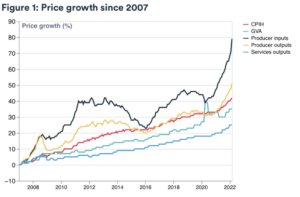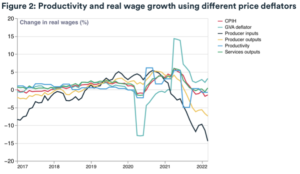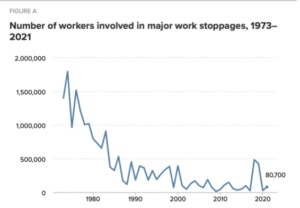Introduction
Currently the Doug Ford Government is in an active dispute with the Canadian Union of Public Employees (CUPE) regarding additional hourly pay as well as other forms of additional pay and support. CUPE is pushing for this because the hourly wages of the workers in the union have not changed in years and comparative to inflation, their purchasing power has gone down, essentially meaning the workers are making less each year. In order to combat this and to try to get additional pay and an improved quality of life by having additional educational assistants in classrooms, which have grown in the number of students under the Ford government, the union is organizing a strike. In contrast, the Ford Government is stating that they have made offers to increase the wages of workers under the union although their offer is significantly lower than the unions demands. They also are stating that they are trying to combat inflation and ensure students are able to attend school rather than having schools closed for strikes. This back and forth dispute is an excellent demonstration of the applicability of game theory to our everyday lives. We can essentially split this scenario into two groups/entities: the Ford Government and the CUPE Union who both can make the choice to either accept the offer proposed by the other group/entity or deny it/make a counter offer. This can be represented in a similar fashion as the prisoner’s dilemma, because although each side is aware of the other’s current/previous choice, they are unaware of the other’s next choice. This can have major impacts on each entity and they must strategize their next choice knowing that the risks escalate the longer the dispute continues. To demonstrate this visually, we have
| CUPE Union | |||
| Ford Government | Accept Current Proposal | Reject Current Proposal and Form New Proposal | |
| Accept Current Proposal | Deal is reached, possibly not as favourable as either side wanted but no more dispute and fair for both sides | Deal is not reached, could lead to more favourable deal for CUPE Union | |
| Reject Current Proposal and Form New Proposal | Deal is not reached, could lead to more favourable deal for Ford Government | No deal is reached, minimal progress is made | |
As we can see, if both sides can come to an agreement then the dispute will come to an end, although the deal may not be as favourable to either side as they wanted. This may lead them to want to act less rationally and choose a more greedy option by rejecting and countering with an offer more favourable to themselves. If this deal gets accepted then they will feel more satisfied because they feel that they have won the dispute, but if it gets rejected then no deal is reached and the dispute will continue on, thus tying up more time and money from both entities as well as having students missing school and teachers not getting paid their regular salary and having to rely on the union to support them.
Game Theory Leading To Strike
To analyze this further, we will analyze the game theory aspects that have led the CUPE Union to initiate and maintain this strike. The CUPE union has stated that it wants an 11.7% annual increase in wages for its education support staff. Although this may seem like a tremendously large increase, especially compared to previous strikes when a 2% increase was considered a large win. However, when looking into this further we can realize that the union is making the only rational choice for its members that it has. Educational workers have received only a roughly 8% increase in their wages in the past decade compared to their counterparts in the public sector who have received an average of 17.6% increase in the past decade, and private sector workers in the educational sector gaining an increase of 13% in the past year alone. Additionally, according to recent data, educational workers have one of the lowest average salaries in the public sector. This data indicating that the public sector educational workers are not getting paid at the same rate as their counterparts may be enough for most people to consider the unions strike rational, but there is further supporting data to indicate that the union is making a rational choice. There have been many studies, such as the figures displayed below, that have shown over time the average price of goods and services have increased significantly in the past decade. In contrast, the average real wage growth, which is the growth of the average person’s wage adjusted for how much they are able to purchase with their wage based on various deflators, has gone down significantly.

 Moreover, an individual worker has little to no power alone in their workplace when trying to demand a fair wage increase to keep up with these trends, but when united they can collectively bargain and demand to be treated fairly. Despite this the number of workers involved in work stoppages has greatly decreased overtime due to union-busting efforts from large corporations and the government, such as Ford’s preemptive attempt to block the union from striking by making it illegal through the “Keeping Students in Class Act” which uses the notwithstanding clause to override fundamental parts of the Charter of Rights and Freedoms.
Moreover, an individual worker has little to no power alone in their workplace when trying to demand a fair wage increase to keep up with these trends, but when united they can collectively bargain and demand to be treated fairly. Despite this the number of workers involved in work stoppages has greatly decreased overtime due to union-busting efforts from large corporations and the government, such as Ford’s preemptive attempt to block the union from striking by making it illegal through the “Keeping Students in Class Act” which uses the notwithstanding clause to override fundamental parts of the Charter of Rights and Freedoms. 
This is because work stoppages can be detrimental to a large corporation or the government and allows the workers to take control of their workplace rather than being controlled and taken advantage of with unfair wages which allow the corporation or government to make more each year since their costs stay flat and earnings go up.
Game Theory Of Maintaining The Strike
With this in mind, the union can see that although as a society we are making more technological progress and becoming more efficient as workers, their educational workers will be having a far harder time because their wages are not keeping up with the inflation of the average price of goods and services. The union can see this struggle for its members, and with the lack of adequate wage increase compared to other counterparts in the same industry in mind, realized that their members are not being treated fairly and that a union has the power to support its workers through collective bargaining and work stoppages. The union attempted to make the rational choice of first negotiating a deal with the government because they know that if they remained civil and bargained they may not have to escalate their dispute and cause a work stoppage which can harm students and the members of the union. However, the Ford government consistently opposed them and did not meet their demands which left them with no rational choice besides escalating their actions further with a strike. This strike can have an immediate short term downside for both the members who risk not getting paid their entire wage and having to rely on the union to pay them and also negatively impacting the students ability to get a proper education since they cannot attend school. However, this is still the most rational choice by the union so long as the strike does not continue too long. The strike will put tremendous pressure on the Ford government to make an agreement with the union so that the students can go back to attending school and the parents who may vote for the Ford government are not frustrated with their lack of action which leaves them having to take care of their child while also working a full time job. The short term reduction in pay for the union members will be outweighed by their long term gain in wages which makes the strike worth the risk, as long as the strike is not prolonged for too long. If the strike continues for too long though, the union may run out of funds to support its members thus meaning they will have an even further lack of wages and possibly be unable to pay their bills. This means that even though they may get the wage increase that they desired if they continue striking, they may not be able to continue the strike because they need money to pay their bills and the wage increase may not make up for their lack of payment in the short term if it continues for too long. This poses a tremendous threat for the union which means that they must push very hard to make a deal quickly with the government in order to keep their members safe, but at the same time not give in too quickly to the governments opposition or else it will make the benefits from the strike outweighed by the cost of it.
Conclusion
Overall, the game theory of this dispute is quite intricate and every choice must be carefully thought through and the benefits must be weighed compared to the drawbacks in a similar fashion to the prisoner’s dilemma. The union must make a choice that will benefit their members in as short of time as possible while also not giving in too early to make the strike not worth their efforts and not solve the game theory problems that led them to make the rational choice of striking. They must make a reasonable and effective counter offer in hopes that the Ford government will also act reasonably and rationally until they can both come to an agreement that may not be as favourable to either entity as desired, but ultimately benefit both entities. If they do not do this however, they both become prone to the other entity getting a deal that is more favourable for the opposition due to the pressure of the situation crippling themselves.
Sources:
Networks. Strikes and Game Theory : Networks Course blog for INFO 2040/CS 2850/Econ 2040/SOC 2090. (n.d.). Retrieved November 7, 2022, from https://blogs.cornell.edu/info2040/2014/09/29/strikes-and-game-theory/
Poydock, R. • B. M. (n.d.). Data show major strike activity increased in 2021 but remains below pre-pandemic levels: Many worker actions were not captured in the data. Economic Policy Institute. Retrieved November 7, 2022, from https://www.epi.org/publication/2021-work-stoppages/
Authors , Authors, & Jonathan Wadsworth Royal Holloway & Centre for Economic Performance View Profile. (2022, November 2). Are wages keeping up with the cost of living? Economics Observatory. Retrieved November 7, 2022, from https://www.economicsobservatory.com/are-wages-keeping-up-with-the-cost-of-living
Fox, C. (2022, October 31). Education workers in Ontario announce mass walkout amid back-to-work legislation. Toronto. Retrieved November 7, 2022, from https://toronto.ctvnews.ca/cupe-announces-mass-walkout-on-friday-after-ontario-introduces-back-to-work-legislation-1.6131853
Subramaniam, V. (2022, November 4). CUPE’s initial wage ask ambitious but expected when inflation is considered, labour relations experts say. The Globe and Mail. Retrieved November 7, 2022, from https://www.theglobeandmail.com/business/article-ontario-cupe-wages-demands/
One reply on “The Game Theory Behind the CUPE Union Strike”
This post is a great way to simplify a complex issue into a simpler model in order to make it easier to analyze and generalize. However, I’m curious about your choice to use the payoff matrix model, since one of its requirements is that all players/teams select their strategies simultaneously, rather than taking turns (as per the Game Theory Slides, week 8, page 18). I would argue that, in this strike, the sides are unable to select strategies simultaneously, since each side’s possible choices are dependent on its opponent’s previous choice (i.e., CUPE cannot choose to reject Ford’s offer if Ford has not made a new offer on its last turn). Therefore, I believe this particular scenario would be better modeled as a turn-based game.